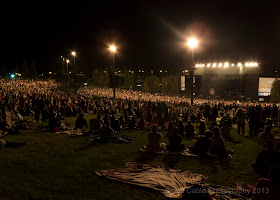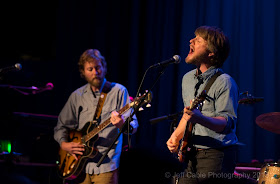We had 2 1/2 days on the bay to shoot. The first half day shoot started at 5pm, with us on the chase boats, scouting the bay and checking out the terrain in the evening light. We came across the AC45 boats which were parked for the night. These boats are used for the youths (25 and under), but had very cool sails, which looked great against the San Francisco background.
The next day, were were out on the bay much earlier and got a chance to shoot images of the AC45s.
Here are all of the boats lined up for a race start, with the Golden Gate Bridge in the background.
One of the New Zealand boats racing against the USA boat, with Coit Tower in the background.
I used my Canon 28-300 at 300mm to zoom into the guys leaning off the boat.
And then, as the AC45 boats were finishing up, we saw one of the Oracle Team USA boats come out for some practice. I was really excited to see these boats in action.
Holy cow! These catamarans are so big and so fast! They reach a top speed of 50mph, which is really cool, but makes it hard to keep up with them and still try to get a good shot. Trust me, we were bouncing all over the place as I shot these images. And for those photographers out there, I was using shutter speeds well over 1/2000 sec to make sure and capture sharp images. Originally I had planned on taking one of my Canon 5D Mark III cameras, but decided to bring the Canon 1DX since it has better weather sealing to protect from water damage.
As always, I was looking for good action shots but also looking for great foreground and backgrounds. In this case, the Oracle boat made a pass by the Bay Bridge and I grabbed this frame. I shot vertically to show the height of the sail. This sail is not fabric, like traditional sails, it is actually a hard material. And the size...the same as a 747 wing.
There is something really invigorating about seeing these massive boats coming straight at you. I zoomed in and grabbed this shot of Boat 17 coming straight at us. Seconds later, we had to make a quick maneuver to get out of their way.
It was impressive to see how fast the sailers move from one side of the boat to the other.
We had our driver position our chase boat so that we could get a shot of the Oracle boat in front of Alcatraz Island.
On the second day, we had smoother conditions on the water and I decided to switch to both the Sigma 120-300 f2.8 lens and the Canon 100-400 lens. And again, I was continually using the full length of the lenses to get really tight shots of the AC72 boats.
Look at the height of the boat off the water. Once these catamarans hit 20 mph, they start to rise up onto the foils. It is amazing to see how quickly and smoothly these cut through the water once they have reached this speed.
This is one of my favorite photos from the shoot. This was taken during the 3rd race and shows the New Zealand team working hard to win the race.
Another shot of the Oracle team rounding a corner marker.
This is another favorite photo of mine, because it shows the AC72 almost fully out of the water and up on it's foils. Honestly, the photo does not do justice to seeing this in person. To see such a large craft come out of the water like this and to see them whip by us, was really something to behold.
And then...after 3 days of shooting, it was time to get some dinner with the other photographer's and videographers and head home. I was exhausted and trying to make it home before 10pm, and then, when driving towards the Golden Gate Bridge, I saw the moon coming up...
At this point, I was still 5 miles from the bridge and I figured that the bay would be covered in fog. But, I was surprised to see that it was mostly clear skies. My wife called me and asked if I saw the moon, and I figured that if everyone else was seeing this, it had to be captured. I shot this with my Canon 24-70 lens, which has become a new favorite for me. Wearing shorts and a t-shirt, I braved the blustery winds and cold weather to get the shot, but I am glad that I did. What a perfect ending to this memorable trip!































.JPG)



.JPG)










